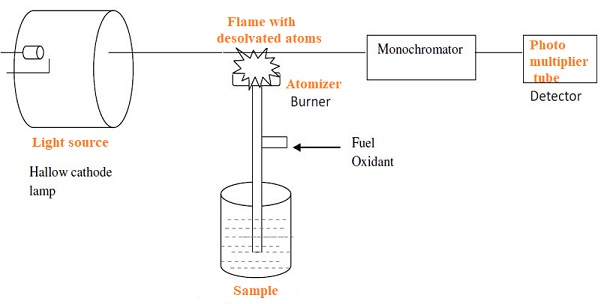atomic absorption spectroscopy in food analysis
In some cases metal content in a material is desirable but metals can also be contaminants poisons. A total of156foods belonging to 8 food groups were studied.

Atomic Absorption Spectroscopy How Does Aas Work Aas Faqs Agilent
Ad Increase efficiency cut through the everyday complexities of your lab.

. AAS is an analytical technique used to determine the concentration of metal atomsions in a sample. The methods best suited to meet this task are atomic spectroscopic methods such as atomic absorption atomic emission and elemental mass spectrometry MS. Atomic absorption spectroscopy AAS is a technique for determining the elemental composition of an analyte present in samples by measuring the absorbed radiation by the chemical element of interest.
The technique has been used widely for the analysis of essential elements such as copper and zinc in various matrices including food products. It is also used in mining operations to determine for instance the percentage of precious. This technique is based on digesting the sample by oxidising the organic matter composition and aspirating converting the digested sample into a liquidgas aerosol the treated sample into a characteristic flame.
Atomization of the sample 2. Atomic Spectroscopy in Food Testing. Atomic Absorption Spectroscopy AA in Food Testing Atomic Spectroscopy AA is a well-established and reliable technique for the analysis of trace elements in food stuffs.
The technique is increasingly being used in the food. Since food is the primary source of essential elements for humans the accurate and precise analysis of food materials is critical. For many years graphite furnace atomic absorption spectroscopy GFAAS has been a reliable technique and the preferred method for this analysis especially for the determination of Cd and Pb.
The basic requirement is that the element of interest be solubilized either in aqueous or certain organic solvents for subsequent aspiration into the flame whereby the atomic absorption AA. Methods commonly used in the generation of food composition data. Agilent has created an innovative atomic spectroscopy portfolio to meet your labs needs.
If one or a. PerkinElmer is the world leader in atomic spectroscopy solutions for atomic absorption AA inductively coupled plasma optical. If one or a few elements are to be determined less expensive atomic absorption spectrometry AAS methods might be more suitable.
Atomic absorption spectrophotometry AAS provides one of the most useful and convenient means for the determination of metallic elements in solution from a wide variety of sample types. ICPAES and ICPMS offer the advantage of providing simultaneous multielement measurements making them well suited for the analysis of large numbers of elements in food samples. Atomic absorption analysis involves measuring the absorption of light by vaporized ground state atoms and relating the absorption to concentration.
Biological analysis Biological samples can include both human tissue samples and food samples. ICPAES ICPMS and more recently GFAAS offer the advantage of providing simultaneous multielement measurements making them well suited for the analysis of large numbers of elements in food samples. Every element has a specific number of electrons associated with its nucleus.
The incident light beam is attenuated by atomic vapor absorption according to Beers law. These very specific wavelengths give the technique excellent specificity and detection limits in the AAS analysis. A compamtive study ofthe determination ofiron in a wide variety offoods was caTried out using the atomic absorption spectrophotometric AAS and phenanthroline colorimetric methods.
These can be divided into the broad categories of biological analysis environmental and marine analysis and geological analysis. Atomic Absorption Spectrometry AAS Information. A major challenge in the analysis of food samples is the extremely low analyte levels and the very high matrix levels.
An Atomic Absorption Spectrophotometry AAS was used for the determination of K Ca Mg Cu Fe Zn Co Ni Cd and Pb. The process of atomic absorption spectroscopy AAS involves two steps. Elemental analysis of food substances presents a challenge because of the wide variety of food types range of concentrations that need to be analyzed and the complexity of food matrices.
There are many applications of atomic absorption spectroscopy AAS due to its specificity. Atomic Absorption Spectroscopy is an analytical technique used for the qualitative and quantitative determination of the elements present in different samples like food nanomaterials. Atomic absorption an established analytical technique that has been used worldwide for decades offers many advantages for an extended range of applications across multiple industries.
Atomic Absorption for Trace Element Analysis in the Food and Beverage Industry. Atomic absorption spectroscopy AAS is based upon the principle that free atoms in the ground state can absorb light of a certain wavelength. Atomic absorption spectrometry AAS is an easy high-throughput and inexpensive technology used primarily to analyze elements in solution.
Absorption All modern Perkin-Elmer atomic absorption instruments are capable of measuring both atomic absorption and atomic emission. What is atomic absorption spectroscopy. It is important for the operator to understand the processes that occur in each technique.
Absorption for each element is specific no other elements absorb this wavelength. As such AAS is used in food and beverage water clinical research and pharmaceutical analysis. Metals make up around 75 of the earths chemical elements.
October 24 2012 By Hazel Dickson.

Atomic Absorption Spectrometer Aas Youtube
Atomic Absorption Spectroscopy Msrblog

Optimization Of Instrument Conditions For The Analysis For Mercury Arsenic Antimony And Selenium By Atomic Absorption Spectroscopy Sciencedirect

Atomic Absorption Spectroscopy Guide To Instrumentation Applications

A Guide To Atomic Absorption Techniques And Applications Aurora Biomed

Pdf Application Of Atomic Absorption Spectroscopy In Food Sciences A Study On Cucurbita Maxima

Atomic Absorption Spectroscopy Principles And Applications Technology Networks

Atomic Absorption Spectroscopy An Overview Sciencedirect Topics
0 Response to "atomic absorption spectroscopy in food analysis"
Post a Comment